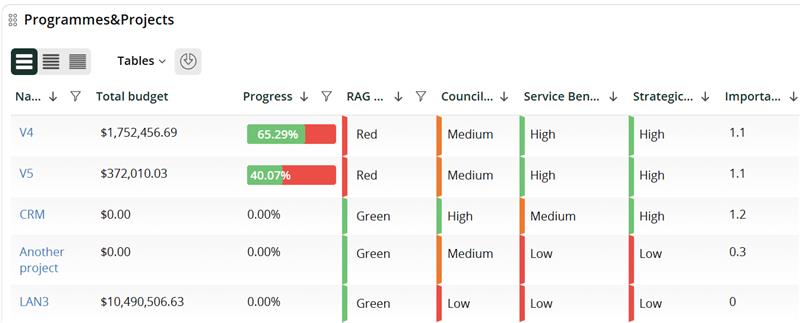
Mastering Project Prioritisation: A Practical Guide to Building Effective Prioritisation Matrices
When I attend networking events and people discover that I’m a portfolio, programme and project management specialist, one of the most frequently asked questions I get is: “How do you actually prioritise projects in a portfolio?” It’s a question that sits at the heart of effective project portfolio management and frankly, it’s one that many organisations find difficult.
Over the course of my career I’ve witnessed countless teams struggling with competing priorities, senior leaders making gut-feeling decisions about multi-million-dollar investments and perfectly good projects failing just because they were tackled in the wrong order. I’ve seen councils struggling to prioritise community projects against infrastructure needs and energy companies wrestling with balancing regulatory requirements against commercial opportunities. The result? Wasted resources, missed opportunities and frustrated stakeholders.
This is why I rate prioritisation matrices – they’re not just academic frameworks, they’re practical tools that can improve project selection and resource allocation, regardless of sector.
This article shows you how to design and implement a simple but effective prioritisation matrix that actually works.
What Is a Prioritisation Matrix?
In simple terms, a prioritisation matrix is a table that lets you rank ideas or projects in order of importance, using pre-defined criteria and weightings. It shows you the projects that will give you the best return for your investment as well as the projects that won’t contribute as much to your organisational goals.
The best thing about a prioritisation matrix is its flexibility. It can be as complex or as simple as you need it to be. I’ve seen effective matrices that fit on a single sheet of A4 paper and others that span complex spreadsheets with dozens of criteria. For example, Hamilton City Council uses their prioritisation framework to evaluate 22 growth scenarios for their 10 year capital planning. The key is finding the right balance between metrics and usability.
Prioritisation matrices support transparent decision-making. Instead of prioritising whoever shouts loudest or the pet project of the most senior person in the room, you’re making decisions based on objective criteria that everyone can see and understand.
So How Do You Design a Prioritisation Matrix?
Building an effective prioritisation matrix isn’t difficult but it does take time and careful planning.
Step 1: Decide the Outcome You Want to Measure
Before you start building your matrix you need to understand exactly what you want to achieve. It needs to be specific and measurable as this is the foundation of the entire process. Statements like “improving customer satisfaction” or “improving revenue” are too vague and won’t help when developing the matrix.
For example, you might be an energy company that has a strategic goal of improving grid reliability by 15%. Or a council aiming to deliver $50 million of community infrastructure improvements within budget. This will be the outcome that you want to assess all of the initiatives and projects against.
Case Study: Strategic Prioritisation in Practice Contact Energy faced the challenge of prioritising infrastructure projects across their renewable energy portfolio. Rather than relying on gut feelings, they established clear strategic outcomes: maintaining 99.5% grid reliability whilst transitioning to renewable sources. This specific, measurable goal became the foundation for evaluating every potential project against their strategic objectives.
Organisations often skip this step or make a half-hearted effort and this undermines everything else that follows.
Step 2: List the Criteria You Will Assess Ideas or Projects Against
This is where you start developing the specific metrics that you will measure your projects or ideas against. Your list should have everything that you will measure but don’t worry about rankings or priorities at this point, that comes later.
The criteria will vary significantly depending on your sector and strategic goals. For energy companies managing infrastructure portfolios, your list might contain:
- Regulatory compliance requirements
- Grid reliability impact
- Environmental and sustainability benefits
- Customer impact and service continuity
- Asset lifecycle and maintenance considerations
- Implementation costs and resource requirements
- Risk of operational disruption
- Alignment with renewable energy targets
- Stakeholder and community acceptance
- Scalability across network infrastructure
For councils managing community and infrastructure projects, relevant criteria might include:
- Community benefit and social impact potential
- Alignment with central government priorities
- Long-term sustainability and environmental impact
- Budget and resource constraints
- Public consultation and political feasibility
- Cross-departmental dependencies and synergies
- Statutory and regulatory requirements
- Economic development potential
- Risk of project delays or cost overruns
- Maintenance and operational implications
The key is to be thorough without being overwhelming. I typically recommend between 5 and 10 metrics – fewer than 5 and you’re probably oversimplifying, more than 10 and you risk analysis paralysis.
When developing your metrics, involve the people who will actually be affected by the decisions. This isn’t just about getting better input (although that’s important), it’s about building buy-in for the process. If stakeholders help create the criteria they’re much more likely to accept the results.
Step 3: Decide the Relative Importance of Each Characteristic
Not all metrics are created equal and this is where many prioritisation matrices fall down. You need to weight your metrics based on their relative importance to achieving your outcome.
You can approach this weighting in different ways. At the simple end, you might have a group of key stakeholders sitting in a room and deciding the relative importance of each characteristic. This works well for smaller organisations or when you need to move quickly.
For a more rigorous approach you can create a pairwise comparison matrix. Each characteristic is listed on both the x and y axes. You then compare each metric against every other one, asking “Which is more important for achieving our goal?” and assigning numeric weightings accordingly. The line totals give you the relative importance of each metric.
Here’s how it might work in practice: if you’re a council comparing “community benefit potential” against “implementation speed”, you might decide that community benefit is significantly more important for your long-term strategy and assign it a score of 3 versus 1 for implementation speed.
There are more sophisticated approaches available, like the Analytic Hierarchy Process but this tends to be overkill unless you’re dealing with very high stakes decisions or have stakeholders that require that level of rigour.
Step 4: Decide the Scoring Methodology for Prioritisation
The next step in developing a prioritisation matrix is to decide your scoring mechanism. It needs to be simple enough so that people can apply it consistently but detailed enough to capture the differences between each project.
A common approach is a simple 1 to 5 scale, where 1 is the least likely and 5 is the most likely. Some organisations reverse this, while others use 1 to 10 for more granularity. The specific numbers don’t really matter as long as they’re meaning is clear and they are applied consistently.
What is crucial is defining what each number means for each metric. So, for a council evaluating “implementation costs”, your scale might be defined as:
- 1: Very high cost (>$5M)
- 2: High cost ($2M-$5M)
- 3: Medium cost ($500K-$2M)
- 4: Low cost ($100K-$500K)
- 5: Very low cost (<$100K)
For an energy company evaluating “grid reliability impact”, the scale might look like:
- 1: Significant negative impact on reliability
- 2: Minor negative impact on reliability
- 3: Neutral impact on reliability
- 4: Minor improvement to reliability
- 5: Significant improvement to reliability
You also need to decide what your cut off numbers are and whether they apply at the individual metric or overall project level. If a project scores below a certain value it might be automatically excluded regardless of how well it scores against other metrics. This stops you wasting time on projects that simply aren’t viable.
Step 5: Evaluate Your Ideas or Projects
Now you’re ready to begin prioritising.
Start by creating a matrix with your projects listed as rows and your criteria as columns. For each project, work through each metric and assign a score based on your methodology.
Here’s where I always recommend involving multiple people in the scoring process. Different perspectives will reveal blind spots and challenge assumptions. However, don’t turn this into a team of 5000 – have 3-5 key stakeholders do the scoring independently, then bring them together to discuss significant differences and reach consensus.
For larger organisations this process can first be done by department. Then the top projects from each department can be brought to the overall committee to check the evaluations and then compare them to other projects across the departments.
Real-World Application: Energy Sector Example PowerCo manages complex infrastructure projects across their 29,000km of power lines and 6,200km of gas pipes, serving 473,000 homes and businesses. Each business unit previously had their own approach to project prioritisation, leading to inconsistent decision-making across the network. By implementing a systematic prioritisation framework, they established consistent criteria including regulatory compliance, customer impact, operational efficiency and resource requirements. This unified approach enables them to evaluate competing infrastructure investments objectively, ensuring that critical grid modernisation projects receive appropriate priority alongside routine maintenance and upgrade work.
Let’s say you’re evaluating 5 projects against your criteria. You would work through each project asking questions like: “How likely is this project to have low implementation costs?” “What’s the potential for high dollar savings?” “How quickly can we implement this?” Score each project on each metric, multiply by the weightings you established earlier and sum up the totals.
The result is a prioritised list of projects ranked by their likelihood of helping you achieve your objective. Whether that’s improving infrastructure resilience, delivering community benefits or achieving operational efficiency targets.
Common Pitfalls and How to Avoid Them
Through the years of implementing prioritisation matrices across various organisations, I’ve seen several recurring mistakes that can undermine the entire process:
- The “Perfect Information” Trap: Don’t spend months trying to get perfect scores for every metric. You’re making decisions with incomplete information and that’s okay. Use the best information available and move on – you can refine your approach over time.
- Gaming the System: Sometimes stakeholders try to manipulate scores to favour their preferred projects. Combat this by having clear, objective definitions for each score and involve multiple evaluators in the process.
- Set and Forget: Your prioritisation matrix isn’t a one-time exercise. Markets change, strategies evolve and new information emerges. Review and update your matrix regularly – I typically recommend quarterly reviews for most organisations.
- Over-Engineering: It’s tempting to create incredibly sophisticated matrices with dozens of criteria and complex weightings. Resist this urge! A simple matrix that people actually use is infinitely better than a complex one that sits on the shelf.
Making It Stick: Implementation Tips
Having a great prioritisation matrix is only half the battle – you need to embed it into your organisation’s decision-making processes for it to work and deliver value.
Start by piloting the approach with a small set of projects or a single department. This lets you refine the process and build credibility before rolling it out more broadly. Make sure you communicate the results clearly, showing how the matrix led to specific decisions, and eventually, better outcomes.
Train your team on how to use the matrix properly. This isn’t just about the mechanics of scoring – it’s about understanding the principles behind the approach and why consistent application matters.
Finally, be prepared to refine your approach. The first version of your matrix won’t be the last and that’s fine. Gather feedback, observe how it’s working in practice and make adjustments as needed.
What Next?
At this point, you will have a robust framework for making prioritisation decisions and a ranked list of projects that will help you achieve your objectives.
But here’s the thing: having prioritised projects is only the beginning. Next you need to consider the dependencies between projects. Then you have to balance your portfolio – most organisations don’t have enough money or resources to deliver every project. Once you’ve done all of that and picked the right projects to do right now, you still need to execute them effectively, manage stakeholders, deliver on time and within budget and actually realise the benefits you’ve identified. This is where strong programme and project management capabilities become essential.
Remember, a prioritisation matrix is a tool, not a magic solution. It will help you make better decisions about where to focus your limited resources but it won’t guarantee success. That still requires all the fundamentals of good project management: clear scope, realistic timelines, adequate resources, strong governance and benefit realisation.
The organisations that get the most value from prioritisation matrices are those that view them as part of a broader commitment to disciplined, evidence-based decision-making. They use the matrix to choose the right projects, then apply equally rigorous approaches to delivering them successfully.
While a spreadsheet can get you started, scaling this process across an entire portfolio often requires dedicated tools designed to integrate prioritisation with execution and benefits realisation.
Psoda Plug
If you’re looking for a tool to help you prioritise your projects and manage them through to successful completion, then look no further than Psoda – because great prioritisation deserves great execution to match.
If you’re interested in seeing how integrated portfolio management can transform your prioritisation and delivery processes, we offer free personalised demos where we can show you exactly how Psoda might work for your specific situation.


